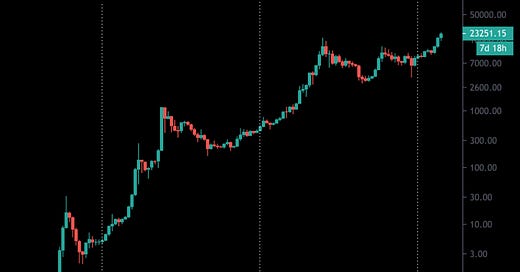

Discover more from The Held Report
You probably first heard of Bitcoin in 2013 or 2017 when friends and family were talking about the wild swings in price.
Bitcoin’s market cycle is typically around 4 years and some hypothesize the cycle is induced by halvings (a reduction in new supply). The idea being a reduction in supply + increase in demand = number go up. We can call this Bitcoin’s viral marketing loop. Satoshi describes it succinctly:
“As the number of users grows, the value per coin increases. It has the potential for a positive feedback loop; as users increase, the value goes up, which could attract more users to take advantage of the increasing value.” - Satoshi Nakamoto
Note that Satoshi wrote this before Bitcoin was even worth $0.01. In the chart below, we have Bitcoin’s price, and halvings which are the dotted lines. As we can see, a bull run has occurred after each halving.
However, this cycle is different.
Never before has Bitcoin had such strong fundamentals against a macro backdrop (traditional financial system) that highlights exactly why Bitcoin is needed, the narrative is singular, and the ability for global value to flow into Bitcoin has never been easier.
Macro backdrop
While Bitcoin was planted during the 2008 financial crisis, it has blossomed largely during a macro bull run. From 2008 - 2020, the traditional financial markets had a few minor corrections but no recession.
Until COVID came.
When COVID came, the markets plunged. This was Bitcoin’s first real test. Will HODLers be the buyer of last resort? Will Bitcoin go to $0 when the world is on fire?
While Bitcoin suffered a nail bitting plunge during the March 12th liquidity crisis (which affected all assets), Bitcoin survived and surged out of the gates in late 2020 to reach all time highs of $24k.
While Bitcoin recovered, governments across the world engaged in unprecedented money printing (aka stimulus). And when I say unprecedented, I mean never before in all recorded financial history. $10T+ was printed across the world to bolster the traditional finance system. This meant that governments were actively devaluing their currency, which is exactly what Bitcoin was built to protect against.
Most people don’t think about getting earthquake insurance until an earthquake hits. Then the insurance companies are flooded with requests.
Bitcoin was special purpose built to be a store of value in a world where you can’t trust your government or bank. Those moments don’t come around often though, like the 2008 financial crisis.
COVID brought Bitcoin’s value into focus for the world. And because of that, a new market participant started to buy Bitcoin: the institutions.
The institutional herd is here
In late 2017, the meme “the institutional herd is coming” wasn’t wrong, it was just early. When COVID roiled the markets, institutions were searching for safe stores of value. Bitcoin offers a unique store of value that is objectively better than gold, with higher upside potential. And from a portfolio construction perspective, Bitcoin is an uncorrelated asset which improves a portfolio’s sharpe ratio (return per unit of risk). Institutions manage over $100 TRILLION.
Here are the financial institutions and trading legends that have recognized Bitcoin is Gold 2.0 over the last 4 months:
- Fidelity
- JP Morgan
- Bloomberg
- Deutsche Bank
- Citibank
- Jefferies
- Blackrock
- Susquehanna
- Paul Tudor Jones
- Stanley Druckenmiller
- Guggenheim
- AllianceBernstein
- Bill Miller
- Mass Mutual
- Ray Dalio
Singular narrative
In the 2017 bull run, there were many competing narratives to Bitcoin’s “Gold 2.0 narrative.” Many of you probably remember ICOs and the relationships with Ethereum being a “dapp platform.”
Also, Bitcoin was fighting against another narrative which was the confederate fork Bitcoin cash (also pronounced bcash”) which felt that Bitcoin’s purpose was to be a cheap PayPal.
Both the dapp platform and cheap PayPal narratives failed to find traction and have largely faded away.
Right now, Bitcoin’s “Gold 2.0” narrative is the only narrative that is driving the crypto space forward. It is the singular focal point that will continue to accrue attention and purchasing demand.
Additionally, there was very little content to help newcomers understand Bitcoin, and for existing Bitcoiners to maintain the faith. After the 2017 bull run, there was an exponential wave of great content that enabled a higher conversion rate of nocoiners to Bitcoiners.
Availability/Ease of use
In the 2013 and 2017 Bitcoin bull runs, it was relatively hard to buy Bitcoin. Often you had to send a wire and understand how an order book worked.
Now you can buy Bitcoin with PayPal, or your traditional brokerage like Robinhood. Even apps like Cash app and SoFi have Bitcoin purchasing available.
A Bitcoin supercycle
Bitcoin was made for this moment.
It is easier to understand and purchase from a wide variety of places.
What happens when ownership of Bitcoin moves from 0.01% of the world to 1%?
What happens when part of the $100T managed by institutions flows into Bitcoin to preserve wealth?
It certainly won’t be going from $20k to $100k. It could move from $20k to $1M and then only have smaller cycles after. This may be one of the final big cycles.
Hope everyone is enjoying the holidays, and HODL on!
Dan





Really great read Dan. I have been scratching my head about this super cycle and wether or not it will play out. Please talk about it more, specifically price targets. IE- bitocin going to “100k” then drawing down to “30k”. Thanks dan!
You mention great content that makes it easier to turn non bitcoiners into beleivers. I am trying to get my mid 50s parents to invest, any suggestions on what to share with them?